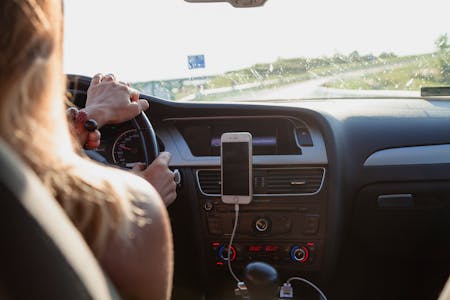

Car accidents are one of the leading causes of death among teenagers in the United States.
While getting a driver’s license is an exciting milestone, it also brings a new level of responsibility.
One major risk that causes many teen car crashes is inexperience. Teens often struggle with hazard recognition, speed control, and decision-making in complex traffic situations. Other factors include distracted driving, speeding, and not wearing seat belts, all of which increase crash risks.
Understanding the causes of teen car accidents is crucial for parents, teens, and policymakers to develop effective strategies for prevention.
Teen Car Collision Stats
| Statistic | Data |
|---|---|
| Fatalities (2021) | 2,400 teens aged 16-19 |
| Increased Crash Risk | 3 times higher than drivers aged 20+ |
| Impact of Passengers | Crash risk increases with each additional passenger |
| Seat Belt Use | Only 60% of teen drivers killed were wearing seat belts |
| Nighttime Fatalities | 40% of fatalities occur between 9 p.m. and 6 a.m. |
| Speeding Factor | 30% of fatal crashes involved speeding |
Overview of Teen Car Accidents
Teen drivers have a significantly higher risk of being involved in car accidents compared to other age groups.
Despite making up only a small percentage of licensed drivers, they account for a disproportionate number of crashes.
Comparative Risk
Teens are three times more likely than drivers aged 20 and older to be involved in a fatal crash.
This elevated risk is primarily due to inexperience and a tendency to underestimate dangerous situations.
Unlike older drivers, teens are still developing their decision-making skills and often struggle to react appropriately in high-stress scenarios, leading to a higher likelihood of accidents.
High-Risk Hours
Teen drivers are more likely to be involved in accidents during certain times, especially at night.
Nearly half of all fatal crashes involving teens occur between 9 p.m. and 6 a.m.
The reduced visibility, fatigue, and increased likelihood of risky behavior contribute to this heightened danger during nighttime hours.
Additionally, weekends tend to see more teen accidents as they are more likely to be out driving with friends or attending social events.
Common Locations
Most teen accidents occur on local roads rather than highways. These roads often have more complex driving scenarios, such as intersections, pedestrian crossings, and frequent stops.
Teens, who are still mastering basic driving skills, may struggle with these challenges.
Neighborhood streets and school zones also present significant risks, especially during peak hours when there is heavy traffic and increased pedestrian activity.
Impact of Weather Conditions
Adverse weather conditions pose a significant challenge for teen drivers.
Rain, snow, and ice create hazardous driving conditions that require experience and caution to handle safely.
Teens, with their limited driving experience, are more likely to misjudge the severity of these conditions, leading to an increased risk of accidents.
Passenger-Related Factors
The presence of passengers can have a significant impact on teen driving behavior, often leading to an increased risk of accidents.
While driving with friends may seem like a harmless and fun activity, it can quickly turn dangerous.
Teens are more susceptible to distractions and peer pressure, which can cause them to make impulsive and risky decisions behind the wheel.
- Increased Distractions
- Peer Pressure
- Higher Crash Risk with Multiple Passengers
- Encouragement of Risky Behavior
- Reduced Use of Seat Belts
- Loud Music and Distractions
- Impaired Judgment
- Late-Night Driving
- Increased Stress Levels
- False Sense of Security
Common Causes of Teen Car Accidents
Teen car accidents are a significant concern due to the unique challenges that young drivers face on the road.
A combination of inexperience, risky behaviors, and external influences contribute to the high accident rates among this age group.
By understanding these common causes, parents, teens, and communities can work together to reduce the risks and promote safer driving practices.
- Inexperience
- Distracted Driving
- Speeding
- Impaired Driving
- Night Driving
- Drowsy Driving
- Seat Belt Non-Use
- Aggressive Driving
- Risk-Taking Behavior
- Overconfidence
By recognizing these common causes of teen car accidents, parents and communities can better support young drivers and implement strategies to improve their safety.
Psychological and Behavioral Factors
Psychological and behavioral factors play a significant role in influencing teen driving behavior. Unlike physical distractions, these internal influences can be more subtle and challenging to control.
Understanding how the teenage brain works and the emotional challenges that come with adolescence is crucial in addressing the root causes of risky driving behaviors among teens.
Risk Perception
Teens often have a limited ability to accurately perceive and assess risk.
This is partly due to their underdeveloped prefrontal cortex—the part of the brain responsible for decision-making and impulse control.
As a result, teens may underestimate the dangers of speeding, running red lights, or texting while driving.
This misjudgment can lead to dangerous situations where they take unnecessary risks, increasing the chances of an accident.
Peer Influence
The presence and influence of peers can significantly impact a teen’s driving behavior.
Teens are more likely to take risks, such as speeding or performing dangerous maneuvers, when they have friends in the car.
This is often driven by a desire to impress their peers or avoid looking cowardly.
These actions, influenced by peer pressure, can result in catastrophic outcomes.
Parents should be aware of this dynamic and consider setting rules about passenger limits for their teen drivers.
Impulse Control
Adolescence is marked by a heightened sense of impulsivity, driven by ongoing brain development.
This impulsivity can manifest in various risky driving behaviors, such as sudden lane changes, tailgating, or failing to stop at red lights.
Teens often act on impulse without fully considering the potential consequences. This lack of impulse control can lead to dangerous situations that they may not have the experience to handle.
Teaching teens to pause and consider their decisions, both on and off the road, can help mitigate these impulsive behaviors.
Emotional State
Teens often experience intense emotions, which can influence their driving behavior.
Feelings of anger, sadness, or excitement can lead to aggressive or careless driving.
Conversely, a teen who is overly excited or happy might pay less attention to their surroundings, making them more prone to distractions.
It’s important for teens to understand how their emotional state can impact their driving and to learn strategies for managing their emotions before getting behind the wheel.
Thrill-Seeking Behavior
Many teens are naturally inclined to seek out new and exciting experiences.
This thrill-seeking behavior can translate into dangerous driving practices, such as speeding, weaving through traffic, or attempting risky stunts.
The thrill of pushing the limits can be appealing, especially when driving gives them a sense of freedom and independence.
Parents should discuss the dangers of thrill-seeking behind the wheel and encourage safer ways to seek excitement.
Stress and Anxiety
Stress and anxiety are common issues among teens, whether due to school pressures, social dynamics, or personal challenges.
These feelings can negatively affect their driving performance by causing them to be distracted or overly cautious.
A teen who is stressed about an upcoming exam might be preoccupied with their worries while driving, making them less attentive to their surroundings.
Similarly, anxiety can cause teens to second-guess themselves, leading to hesitation and erratic driving behaviors.
Teaching teens healthy coping mechanisms for stress and anxiety can help improve their focus and confidence on the road.
Parental Influence
Parents play a significant role in shaping their teen’s driving habits. Teens often model their behavior after what they see from their parents.
If a parent regularly engages in risky driving behaviors, such as speeding, using a phone while driving, or not wearing a seatbelt, their teen is more likely to adopt these habits.
Positive parental influence, on the other hand, can encourage safe driving practices.
Parents should be aware of the impact their own driving habits have and set a good example.
Adolescent Brain Development
During adolescence, the brain is still developing, particularly the areas responsible for decision-making and impulse control.
This biological factor contributes to why teens are more prone to risky behaviors and why they may not always make the safest choices while driving.
The prefrontal cortex, which helps regulate behavior and control impulses, does not fully mature until the mid-20s.
This underdevelopment can lead to teens misjudging situations or reacting inappropriately to sudden changes on the road.
Desire for Independence
The desire for independence is a powerful motivator for teen drivers. Having a driver’s license represents freedom and autonomy.
However, this desire can sometimes lead to risky behavior as teens try to assert their independence and prove their capabilities.
It’s important for parents to discuss the responsibilities that come with driving and to set clear boundaries while allowing their teens to experience the independence they crave in a safe manner.
Sensation Seeking
Sensation seeking, or the pursuit of novel and intense experiences, is a common trait among teens.
This can manifest in dangerous driving behaviors like speeding, drag racing, or experimenting with risky driving maneuvers.
Teens may not fully understand or care about the potential consequences of these actions, focusing instead on the immediate thrill.
Parents and educators should work to provide safe outlets for teens to channel their need for excitement and educate them about the serious consequences of sensation-seeking behaviors on the road.
Protect Your Teen’s Future
Understanding the causes of teen car accidents is the first step in preventing them, but sometimes, despite our best efforts, accidents still happen.
If your teen has been involved in a car accident, it’s important to seek legal guidance to protect their rights and future.
Contact Goldenzweig Law, a trusted Houston car accident attorney, at 713-903-3988 for professional legal assistance.
Navigation
Related Posts


What is a Non Dot Recordable Accident?
Continue Reading

